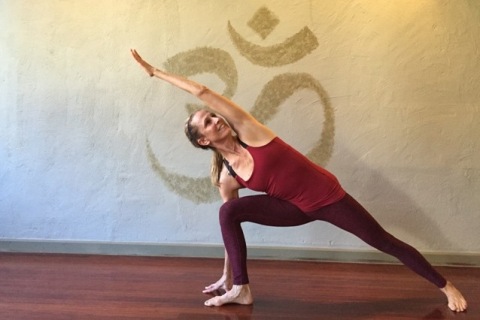In the standing poses there are straight leg poses and bent leg poses. In order to work the legs, and all of the muscles and joints in their full ranges of motion, it is important to commit to the bend when doing bent leg poses and to keep the leg straight when doing straight leg poses. Bent leg poses strengthen the hamstrings and stretch the quadriceps; straight leg poses do the opposite. There are no “hybrid” poses in yoga. If the leg isn’t fully committed to being bent in the bent leg poses, all of the muscles surrounding the knee are tensed and the knee takes the strain. The same thing happens in the straight leg postures when the front leg is not fully straight. Muscles work in reciprocal pairs; when one muscle contracts the opposite one stretches.
The bent leg poses are introduced in Warrior II, Warrior I and Side Angle pose. These three poses all have the front knee bent 90 degrees. In the beginning, it is difficult to bend the leg that deeply. This can be due to tight hamstrings and adductors, tight quads and even a tight psoas in the back leg. But the depth of the bend can be increased over time. And it does have to be consciously worked on. As a teacher, I can often assess if a student is ready for some of the more advanced postures by looking at their ability to bend their knees and open their hips in the introductory standing poses.
It is important to know what you are actually doing in these poses. That is why I often recommend that students practice in front of a mirror. We often deceive ourselves with what we think we are doing. In Sanskrit this is called Avidya, or not seeing things clearly. It can be eye-opening to see what you are actually doing.
These introductory bent leg poses lead us into the more complex postures. The external rotation and bent leg in Warrior II is related to the external rotation and bent leg in poses such as Cobbler’s Pose, One-legged Pigeon and any of the Lotus variations.
Warrior II
Watch this Yoga Journal video to see a 360 degree view of this pose.
In Side Angle Pose, it is hard to get the hand to the floor unless the front leg is bent 90 degrees. The stretch on the side of the body in this pose helps us to elongate and mobilize the torso for twisting. It lays the ground work for Revolved Side Angle Pose and forward bending postures such as Seated Tree and Revolved Seated Tree.
Side Angle
Watch this Yoga Journal video to see a 360 degree view of this pose.
Warrior I prepares us for back bends and for postures where one side of the body is forward bending and the other side of the body is back bending such as it is when doing a split. One-legged King Pigeon Pose has some aspects of this in it, too, as well as the external rotation of the front leg.
Warrior I
Watch this Yoga Journal video to see a 360 degree view of this pose.
Being able to bend your knee 90 degrees in these standing poses does not mean that you have to be able to do it today, but know where you are and where you are going. I have seen students who have been practicing yoga for years never learn to bend their front knee 90 degrees. And they have wondered why they have not made progress in their strength and flexibility.





